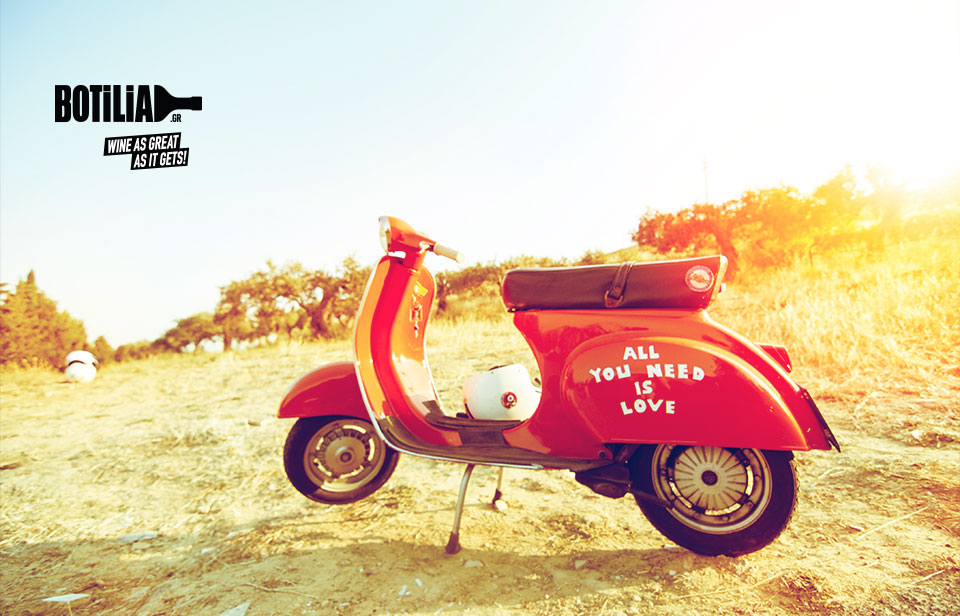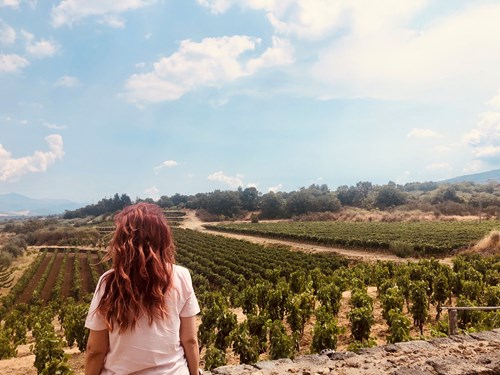THE TOUR OF SICILY IN 5'!

It's been a weird year and many of our plans have been canceled, mainly the trips we have scheduled or dreamed off. But you do not need to worry about it at all because I intend to take you to the enchanting Sicily in just 5 minutes and explore together its wines and gastronomy. Ready?
Sicily is the largest island in the Mediterranean, it has a rich gastronomy and wine history that is lost in the depths of the centuries. Sicily has a bit of everything in terms of wine, plenty of varieties, different styles and quite a lot of PDO (over 20). To be precise, it has 23 DOCs and one DOCG. Some of the more important ones are the following:
Sicilia DOC
Sicilia DOC is a wide PDO, for the whole island. It started in 2011 by a consortium of winemakers that promoted Sicilia IGT to DOC. The dozens of wineries that took part in this action agreed to work together to promote local Sicilian varieties.
Since wines under this name can be made all over the island, DOC is more of a marketing tool to promote Sicily abroad and to familiarize consumers with its range of wines. Wines under the Sicilia Doc umbrella should follow viticulture and winemaking practices set out in DOC regulations.


"Mama Etna", the volcano that still smokes and reminds that it does not sleep is responsible for a unique terroir and for some of the best wines in Italy. The climate of the area is quite different from elsewhere. It is almost alpine with intense sunshine, but receives twice as much rainfall as other areas. Etna's unique wines gained DOC recognition in 1968. Etna's main grapes are Nerello Mascalese and Carricante. The vineyards in Mount Etna are located at a high altitude that often exceeds 1000 meters while the special soil and climate did not allow the infestation by phylloxera. As a result, Mount Etna currently has vineyards that can be over 200 years old.
Vittoria DOCG Cerasuolo
Compared to Mount Etna, the southeastern corner of Sicily offers lower altitudes and higher temperatures. This makes it a great location for perfect ripening of red varieties and the source of the unique DOCG of Sicily, Cerasuolo di Vittoria.
Cerasuolo di Vittoria is a red wine, a blend of red varieties introduced as DOCG in 2005. Nero d’Avola should make up 50% -70% of the blend, with the rest topped by Frappato. It gives elegant red wines full of red fruits such as strawberry and cherry (cerasuolo means cherry), underlined with notes of licorice, flowers and leather.
There are two quality categories of Cerasuolo di Vittoria: rosso and classico. The first must have an 8 -month maturation, while the second have to be matured for at least 18 months.
Marsala DOC
The city of Marsala is located in southwestern Sicily and has suffered quality problems for half a century, but this historic port has returned to its glory. The main varieties of its famous fortified used to be Inzolia and Catarratto, but nowadays Grillo is preferred in an effort to create better quality wines. Not all Marsala are whites. In fact, 10 varieties are allowed, including Nerello Mascalese and Nero d’Avola red grapes.
Like Sherry, Marsala has many categories related to aging. Color and residual sugars are written on the bottle. The shades are divided into oro (gold), ambra (amber) and rubino (ruby), while for sweetness, the categories are secco (dry at 40g / L, or grams per liter), semisecco (semi-sweet at 40-100g / L ) and dolce (sweet with more than 100g / L).
The grape varieties of Sicily
Sicily has several local varieties but some of them stand out. These are: Nero d'Avola, Nerello Mascalese, Frappato, Grillo and Catarratto.
Nero d'Avola
Nero d'Avola is the most widely planted and well-known red grape in Sicily. Black of Avola, as its name implies, gives wines with deep purple color, medium body, moderate (+) acidity and moderate tannins. It has aromas of red and black fruits such as cherry, sour cherry and plum framed by notes of chocolate and sweet spices (in oaked versions). It can give different styles of wines ranging from juicy, fruity and easy to drink to intense and complex, with good aging potential. Nero d'Avola is one of the 2 varieties of Cerasuolo di Vittoria Denominazione di Origine Controllata e Garantita (DOCG).
Nerello Mascalese
Nerello Mascalese may be second in plantings, after Nero d'Avola, but in the last 20 years its reputation and value are keep growing. The grape thrives in the volcanic soils of Mount Etna and is often blended with Nerello Cappuccio, a rustic, spicy grape. It gives wines with intense fruity and floral character, medium body, crisp acidity and moderate tannins (the Sicilians call them galoppante, (galloping) because they build up as you drink or as long as you have the wine in your mouth, like the intensity of the horse gallop while running). They have great aging potential and evolve very nicely over time.
Frappato
Frappato, although usually blended, can also be bottled on its own. It is the second variety of Cerasuolo di Vittoria Denominazione di Origine Controllata e Garantita (DOCG). In the single varietal version, it gives wines with intense floral character and aromas of red fruits. In recent years it has become more and more popular in sommelier circles as its delicate body, refreshing acidity and soft tannins make it very versatile in combination with food.
Catarratto is the most widely planted white grape variety that gives light, pleasant, aromatic wines. Since they take advantage of its large acreage yields, it often gives economical, everyday wines that can be found in all the trattorias of Palermo! Along with Grillo, they participate in Marsala blend. Grillo gives wines of medium volume and acidity, with aromas of stone fruits and white flowers (a bit reminiscent of our Malagouzia).
The history of Sicily
The history of wine in Sicily, strange as it may seem to you, began with the Greeks, who colonized the island in the 8th century BC. They brought with them all the techniques of viticulture and winemaking. Later, the Romans and the Phoenicians contributed to the wine culture of the island. It’s interesting that Sicilian wines have been an exportable product of the island ever since. Local varieties and some traditional techniques are still used today and have made Sicily a top wine destination. Its many and different settlers have left their mark on gastronomy, culture and architecture. This is what makes it so enchanting, after all.
The regions of Sicily
I find it very difficult to choose my favorites but ok, this article has to end somewhere. Apart from Mount Etna and Marsala which you should definitely visit for its wines and wineries, but also because they are truly magical places, you should visit the following too:
Trapani
Trapani is the port where Peter of Aragon landed in 1282 to begin the Spanish occupation of Sicily. Trapani has the shape of a scythe and so its name is a paraphrase of the Greek word drepani (scythe). Legend has it that a scythe fell from Saturn's hands and turned into a strip of land where the Elymians found Trapani. It is a seaside place with beautiful picturesque beaches and surrounding islands. A few minutes from the city center you may find Trapani and Paceco Nature Reserve: this place is really worth a visit, as its beauty is truly unique and its special environment makes it suitable for many migratory bird species - pink flamingos and cranes. The place is famous for its fresh tuna but also for the almond pesto. A must - try!
Palermo
Words fall short of Palermo! This place has a charm but also a mystery. Palermo, like the rest of Sicily, is considered one of the most traditional "strongholds" of mafia. An absolute must is a visit to the Cathedral, the Palace of the Normans and the Archaeological Museum Antonio Salinas. If you like flea markets then take a stroll through Ballaro Market, where the heart of Palermo beats. It also has a beautiful marina and nearby the amazing Mondello beach which is worth a swim.
Syracuse
As you can probably understand from the name we are talking about a Greek colony. Taking a walk in the center you will see ancient Greek inscriptions and capitals everywhere. The Greek element is strong. It is rumored that she was the birthplace of Archimedes. Take a stroll to the Fontana d’Arethusa fountain and the enchanting center of Ortygia.
Catania
Under the shadow of Mount Etna is the seaside town of Catania with its picturesque alleys and squares. Small, cozy restaurants spring up from everywhere to enjoy your Aperitivo and appealing wine bars invite you to try Sicilian wines. Wander around the beautiful churches and monuments such as the historic San Benedetto Convent and the Palazzo Biscari.
Cefalu
It is probably the most cosmopolitan beach in Sicily, with turquoise, crystal clear waters and stunning view. As you swim you can gaze across the old castles that are carved into the rocks. Extra tips: it has an impressive sunset that you can see while eating your fish or drinking your wine in one of the seaside restaurants. Dive from the old port is a must. In the city center you can explore the medieval alleys while eating gelato.
Taormina
For some it is the most beautiful and cosmopolitan city in Sicily. Perched on the slope of Monte Tauro it has incredible view across the coastline. It is worth visiting Teatro Greco which is an ancient Greek theater, but also the church of San Giuseppe. If you are looking for the latest fashion trends, in Taormina you can find them all. At Corso Umberto, the rococo aesthetic meets Italian fashion, with the boutiques of the most famous houses.
The gastronomy of Sicily
Get paper and pen, the list is long. In addition to wine, Sicily has plenty of lemons, pistachios and seafood. For starters, let me tell you that it is the homeland of arancini and cannoli. Arancini means small orange and it got that name due to its round shape and golden color. These are rice croquettes (we are practically talking about the leftovers of risotto) which are filled with everything you can imagine, from cheese to meat and seafood, and then they are deep fried. It is something like local street food. Cannoli on the other hand are rolls of crumbly dough filled with cream (traditionally from ricotta) and crushed pistachio. You can find them in many variations and it is worth trying them all. Also do not forget to eat pasta ala Norma, with eggplants and tomatoes (and fresh tuna if you are lucky), sfincione (something like pizza with tomatoes, olives and anchovies) and caponata (cooked with eggplants, raisins, garlic, capers, peppers and pine nuts). In Sicily they also make a very fragrant pistachio pesto. You can find it with rather lemon or tomato. We are also talking about fish lover’s paradise: pasta with sardines, octopus stew and calamarata pasta (squid shaped pasta cooked with squid of course, tomato or lemon and other seafood).
Let's go to dessert! Since we are talking about Italy, gelato reigns and specifically gelato sandwich, with syrupy, hot brioche (yes, it is as hellish delicious as it sounds). Finally, Sicily has its own chocolates, made with the ancient recipe of Aztecs. The Spanish conquerors brought the recipe with them and the people at Modica, learned it and make it to this day (personally I could live without trying them but you can experiment).
Bonus tip: They are very sensitive about mafia, so do not make any reference, not even for a joke! I emphasize this because you can very easily start a conversation since the Sicilians are quite hospitable and they are very happy whenever they meet a Greek (Magna Grecia ftr).
Eva Markaki
Wine Geek


